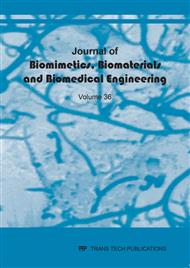[1]
W. A. Mustafa, H. Yazid, S. Yaacob, and S. Basah, Blood vessel extraction using morphological operation for diabetic retinopathy,, IEEE Reg. 10 Symp., no. 3, p.208–212, Apr. (2014).
DOI: 10.1109/tenconspring.2014.6863027
Google Scholar
[2]
W. M. Haschek, C. G. Rousseaux, M. A. Wallig, L. Teixeira, and R. R. Dubielzig, Eye," in Haschek and Rousseaux,s Handbook of Toxicologic Pathology, 2013, p.2095–2185.
DOI: 10.1016/b978-0-12-415759-0.00053-4
Google Scholar
[3]
James Garrity, Whitney, and Betty MacMillan, Structure and Function of the Eyes - Eye Disorders., [Online]. Available: http://www.merckmanuals.com/home/eye-disorders/biology-of-the-eyes/structure-and-function-of-the-eyes. [Accessed: 28-Aug-2017].
Google Scholar
[4]
P. H. Scanlon, Diabetic retinopathy,, Medicine, vol. 38, no. 12. p.656–660, (2010).
Google Scholar
[5]
P. V. Priya, A. Srinivasarao, and J. V. C. Sharma, Diabetic Retinopathy - Can Lead To Complete Blindness,, Int. J. Sci. Invent. Today, vol. 2, no. 4, p.254–265, (2013).
Google Scholar
[6]
A. A. Alghadyan, Diabetic retinopathy - An update,, Saudi Journal of Ophthalmology, vol. 25, no. 2. p.99–111, (2011).
DOI: 10.1016/j.sjopt.2011.01.009
Google Scholar
[7]
W. A. Mustafa, H. Yazid, and S. Yaacob, Illumination Correction of Retinal Images Using Superimpose Low Pass and Gaussian Filtering,, in International Conference on Biomedical Engineering (ICoBE), 2015, p.1–4.
DOI: 10.1109/icobe.2015.7235889
Google Scholar
[8]
W. A. Mustafa, H. Yazid, and W. Kamaruddin, Combination of Gray-Level and Moment Invariant for Automatic Blood Vessel Detection on Retinal Image,, J. Biomimetics, Biomater. Biomed. Eng., vol. 34, p.10–19, (2017).
DOI: 10.4028/www.scientific.net/jbbbe.34.10
Google Scholar
[9]
G. S. Ramlugun, V. K. Nagarajan, and C. Chakraborty, Small retinal vessels extraction towards proliferative diabetic retinopathy screening,, Expert Syst. Appl., vol. 39, no. 1, p.1141–1146, (2012).
DOI: 10.1016/j.eswa.2011.07.115
Google Scholar
[10]
R. Geetharamani and L. Balasubramanian, Retinal blood vessel segmentation employing image processing and data mining techniques for computerized retinal image analysis,, Biocybern. Biomed. Eng., vol. 36, no. 1, p.102–118, (2016).
DOI: 10.1016/j.bbe.2015.06.004
Google Scholar
[11]
V. Štruc, B. Vesnicer, F. Mihelič, and N. Pavešić, Removing illumination artifacts from face images using the nuisance attribute projection,, in ICASSP, IEEE International Conference on Acoustics, Speech and Signal Processing - Proceedings, 2010, p.846.
DOI: 10.1109/icassp.2010.5495203
Google Scholar
[12]
W. A. Mustafa, H. Yazid, A. S. Abdul-nasir, and M. Jaafar, An illumination normalization on face images : A comparative review,, J. Adv. Res. Des., vol. 35, no. 1, p.1–9, (2017).
Google Scholar
[13]
W. A. Mustafa and H. Yazid, Illumination and Contrast Correction Strategy using Bilateral Filtering and Binarization Comparison,, J. Telecommun. Electron. Comput. Eng., vol. 8, no. 1, p.67–73, (2016).
Google Scholar
[14]
W. A. Mustafa, H. Yazid, and S. Yaacob, Illumination Normalization of Non-Uniform Images Based on Double Mean Filtering,, in IEEE International Conference on Control Systems, Computing and Engineering, 2014, p.366–371.
DOI: 10.1109/iccsce.2014.7072746
Google Scholar
[15]
E. H. Land and J. J. McCann, Lightness and Retinex Theory,, J. Opt. Soc. Am., vol. 61, no. 1, p.1–11, (1971).
Google Scholar
[16]
R. Wallis, An approach to the space variant restoration and enhancement of images,, in Symposium on Current Mathematical Problems in Image Science, (1976).
Google Scholar
[17]
D. B. Judd, Hue Saturation and Lightness of Surface Colors with Chromatic Illumination,, J. Opt. Soc. Am., vol. 30, no. 1, p.2, (1940).
DOI: 10.1364/josa.30.000002
Google Scholar
[18]
Y. Wang, W. Tan, and S. C. Lee, Illumination normalization of retinal images using sampling and interpolation,, in Proceedings of SPIE, 2001, vol. 4322, p.500–507.
Google Scholar
[19]
Ø. Osnes, Diabetic retinopathy: automatic detection of early symptoms from retinal images.,, in In: Proc. NORSIG-95 Norwegian Signal Processing Symposium., (1995).
Google Scholar
[20]
M. Foracchia, E. Grisan, and A. Ruggeri, Luminosity and contrast normalization in retinal images,, Med. Image Anal., vol. 9, p.179–190, (2005).
DOI: 10.1016/j.media.2004.07.001
Google Scholar
[21]
D.A. Forsyth, Homomorphic filter,, Int J. Comput. Vis., vol. 5, p.5–36, (2010).
Google Scholar
[22]
S. K. Shome, S. Ram, and K. Vadali, Enhancement of Diabetic Retinopathy Imagery Using Contrast Limited Adaptive Histogram Equalization,, Int. J. Comput. Sci. Inf. Technol., vol. 2, no. 6, p.2694–2699, (2011).
Google Scholar
[23]
T. Yedidya and R. Hartley, Tracking of Blood Vessels in Retinal Images Using Kalman Filter,, in Digital Image Computing: Techniques and Applications (DICTA), 2008, 2008, p.52–58.
DOI: 10.1109/dicta.2008.72
Google Scholar
[24]
M. Al-Rawi, M. Qutaishat, and M. Arrar, An improved matched filter for blood vessel detection of digital retinal images,, Comput. Biol. Med., vol. 37, no. 2, p.262–267, (2007).
DOI: 10.1016/j.compbiomed.2006.03.003
Google Scholar
[25]
C. R. Dhivyaa, K. Nithya, and M. Saranya, Automatic Detection of Diabetic Retinopathy from Color Fundus Retinal Images,, Int. J. Recent Innov. Trends Comput. Commun., vol. 2, no. 3, p.533–536, (2014).
Google Scholar
[26]
H. A. Rahim, A. S. Ibrahim, W. M. D. W. Zaki, and A. Hussain, Methods to enhance digital fundus image for diabetic retinopathy detection,, Proc. - 2014 IEEE 10th Int. Colloq. Signal Process. Its Appl. CSPA 2014, p.221–224, (2014).
DOI: 10.1109/cspa.2014.6805752
Google Scholar
[27]
W. A. Mustafa and H. Yazid, Background Correction using Average Filtering and Gradient Based Thresholding,, J. Telecommun. Electron. Comput. Eng., vol. 8, no. 5, p.81–88, (2016).
Google Scholar
[28]
W. A. Mustafa, H. Yazid, M. Jaafar, M. Zainal, A. S. Abdul-, and N. Mazlan, A Review of Image Quality Assessment (IQA): SNR, GCF, AD, NAE, PSNR, ME,, J. Adv. Res. Comput. Appl., vol. 7, no. 1, p.1–7, (2017).
Google Scholar
[29]
W. A. Mustafa, H. Yazid, and S. Yaacob, A Review : Comparison Between Different Type of Filtering Methods on the Contrast Variation Retinal Images,, in IEEE International Conference on Control System, Computing and Engineering, 2014, p.542–546.
DOI: 10.1109/iccsce.2014.7072777
Google Scholar


